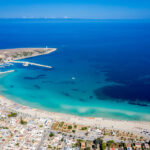A cultural journey among mosaics with mythological scenes, chariot races and… girls in bikinis!
In the heart of Sicily, on the Southern Erei Mountains, at a height of about 700 meters, stands an ancient city among the most important cultural tourist destinations in the region: Piazza Armerina.
Famous for the presence of the Villa Romana del Casale, with its magnificent mosaics, Piazza Armerina has much more to offer visitors, with its medieval historic center characterized by a mixture of styles, from Norman to Baroque. It was not for nothing that in 1512 Emperor Charles V had given it the title of Urbs Opulentissima (very rich city).
Obviously, the Villa Romana del Casale is the main attraction of Piazza Armerina. Inserted among the UNESCO World Heritage Sites in 1997, the structure, which has the characteristics of the Roman imperial urban palace, was built in the Constantinian age, in the first half of 300 AD, and is composed of four rooms: the monumental entrance, the central body (which develops around a peristyle courtyard), a trichora with an ovoid peristyle and a thermal complex. Inside there are 60 rooms, of which 48 rooms, which contain more than 3,500 square meters of floors decorated with polychrome mosaics of great artistic importance and more: alongside the mythological scenes we find, in fact, there are parties, hunting scenes, competitions, training and domestic life… This is unique information about the culture and life in the late imperial Roman era.
Among the most important mosaics we find that of the Grande Caccia which covers an entire corridor over 65 meters long and 5 meters wide. The enormous mosaic was created by two different workers because there are obvious stylistic differences between the southern and northern parts. The scene, despite its name, does not represent a hunting trip but the capture of the animals, probably destined for the Colosseum for the fight against the gladiators.
The mosaic of the Fanciulle in Bikini is among the most famous of the Villa Romana del Casale: it shows young women intent on training while wearing a “two-piece” that seems to anticipate by about 1600 years the invention of the French tailor Louis Réard, inventor of the bikini in 1946. The athletes are training in discus throwing, running and weights; two of them are playing with a ball while two others are rewarded by the only girl dressed in a cloak, probably the judge of the competition. The room with the Fanciulle in Bikini also presents another peculiarity: originally it was decorated with mosaics with geometric motifs, still visible in a corner, which were subsequently covered by the new mosaic.

In the atrium of the spa complex there is a mosaic representing the Circo Massimo during a chariot race. It is a mosaic full of details, with the race narrated in all its phases, from the jails (the boxes from which the four carts started) to the award ceremony. During the race you can also see the overturning of a quadriga, that of the red faction.
Among the mosaics of mythological subjects, we cannot fail to mention the one that tells the episode of Ulysses while he gets Polyphemus drunk (a song of the Odyssey set in Sicily which we talk about in depth in the Sicily for Kids section), which is located in the antechamber of the northern apartment. In the mosaic, Ulysses offers a skin of wine to Pifemo, who is represented with three eyes while he is tearing a ram with his hands.
Not all the rooms of the Villa Romana del Casale are paved with mosaics. The Basilica, a large apsidal room which served as a public reception, has a colored marble and porphyry floor.
Discovered in 1950 by the archaeologist Gino Vinicio Gentili, the Villa Romana del Casale is, also thanks to its perfect state of conservation, one of the best ways to immerse yourself in the art and culture of the Roman Empire.
In addition to the magnificent Roman villa, Piazza Armerina offers its visitors many other beauties to discover, starting with the Cathedral of Maria Santissima delle Vittorie, whose dome, at over 76 meters, is the highest in Sicily. The Cathedral presents a great mixture of styles, from Gothic to Baroque. The bell tower, 40 meters high, is in Gothic-Catalan style and belonged to the church that stood on the same spot before the construction of the cathedral. The position is the highest in the city, so as to make the building and its dome stand out above the entire Piazza Armerina. The exterior is made of sandstone, while inside there is a silver baptistery by Antonello Gagini and a painted wooden cross on the front and recto.
Among the most important religious buildings are the Church of San Pietro and that of San Rocco. The first has, inside, a decorated coffered ceiling and a large painting depicting the Madonna with St. Anthony and donors, probably the work of Caravaggio or his school. The Church of San Pietro was built together with the adjacent monastery by Benedictine monks fleeing from the nearby rural village of Fundrò. The marble statue of the Madonna inside the church comes from the ancient abbey.
Among the civil buildings, Palazzo Trigona della Floresta is located near the cathedral: it is a three-storey building built around 1690 in sandstone. The Palace now houses the Archaeological Museum. The Aragonese Castle was built in the fourteenth century for defensive purposes. It became a prison during the 1800s and has now been restored. The interior cannot be visited. The Garibaldi Theatre is one of the oldest municipal theatres in Sicily. The building dates back to the eighteenth century while its ceiling was frescoed by Giuseppe Paladino in the early 1900s.
With its Villa Romana del Casale, its churches and its buildings, Piazza Armerina promises visitors a historical and artistic journey lasting almost two thousand years and represents one of the most culturally important places in all of Sicily.





Comments are closed.